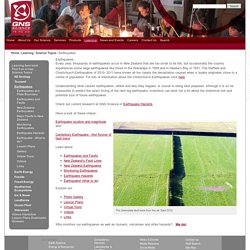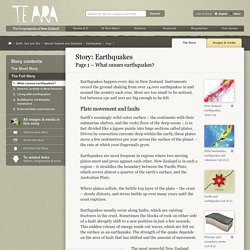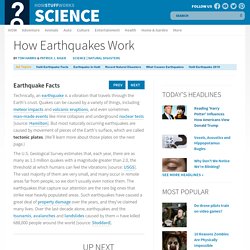

NZ Geographic. Earthquakes / GNS - NZ. Skip to main content Disclaimer and Copyright Staff Search Home / Learning / Science Topics / Earthquakes Learning feed back Find it on a map Science Topics Videos Interactive Lesson Plans Downloads Glossary Earthquakes Every year, thousands of earthquakes occur in New Zealand that are too small to be felt, but occasionally the country experiences some large earthquakes like those in the Wairarapa in 1855 and in Hawke’s Bay in 1931.

Understanding what causes earthquakes, where and why they happen, is crucial to being best prepared. Check out current research at GNS Science in Earthquake Hazards. Have a look at these videos: The Greendale fault trace from the air, Sept 2010 Earthquake location and magnitude and Canterbury Earthquake - first flyover of fault trace Learn about: Explore our: Who monitors our earthquakes as well as tsunami, volcanoes and other hazards? Our Science. Causes of Earthquakes. Earthquakes happen every day in New Zealand.

Instruments record the ground shaking from over 14,000 earthquakes in and around the country each year. Most are too small to be noticed, but between 150 and 200 are big enough to be felt. Plate movement and faults Earth’s seemingly solid outer surface – the continents with their submarine shelves, and the rocky floor of the deep ocean – is in fact divided like a jigsaw puzzle into huge sections called plates. Driven by convection currents deep within the earth, these plates move a few centimetres per year across the surface of the planet – the rate at which your fingernails grow. Earthquakes are most frequent in regions where two moving plates meet and press against each other. Where plates collide, the brittle top layer of the plate – the crust – slowly distorts, and stress builds up over many years until the crust ruptures.
Earthquakes usually occur along faults, which are existing fractures in the crust. Goodbye to the Richter scale. How Earthquakes Work. Technically, an earthquake is a vibration that travels through the Earth's crust.

Quakes can be caused by a variety of things, including meteor impacts and volcanic eruptions, and even sometimes man-made events like mine collapses and underground nuclear tests [source: Hamilton]. But most naturally occurring earthquakes are caused by movement of pieces of the Earth's surface, which are called tectonic plates. (We'll learn more about those plates on the next page.) The U.S. Earthquakes in New Zealand. Shaky New Zealand About 14,000 earthquakes are recorded in and around New Zealand every year.

Fortunately, most of them are too small for us to feel at the surface. However, many of us have felt the shake of an earthquake, and there are some big ones that have become part of New Zealand history. The earthquake in and around Christchurch in February 2011 was devastating, and reminded people around the country that they too must be prepared for ‘the big one’. (Earthquakes are measured on the Richter scale.) The occurrence of destructive earthquakes is unpredictable, but communities and rescue organisations prepare as much as they can. Why does New Zealand get earthquakes? Earthquakes and volcanoes are common around the world where one tectonic plate is sinking under another at a subduction zone. What causes earthquakes? At a subduction zone, two tectonic plates try to pass each other. The seismic waves travel at different speeds. Earthquake research Research includes trying to: New Zealand Earthquakes. For centuries before Europeans arrived, Māori had experienced rū whenua, which means ‘the shaking of the land’.

According to Māori tradition, earthquakes are caused by the god Rūaumoko (or Rūamoko), the son of Ranginui (the Sky) and his wife Papatūānuku (the Earth). Rangi had been separated from Papa, and his tears had flooded the land. Their sons resolved to turn their mother face downwards, so that she and Rangi should not constantly see one another’s sorrow and grieve more. When Papatūānuku was turned over, Rūaumoko was still at her breast, and was carried to the world below. To keep him warm there he was given fire. The wrath of the taniwha In Māori tradition some earthquakes were attributed to taniwha, dragon-like monsters. Māori accounts of earthquakes.